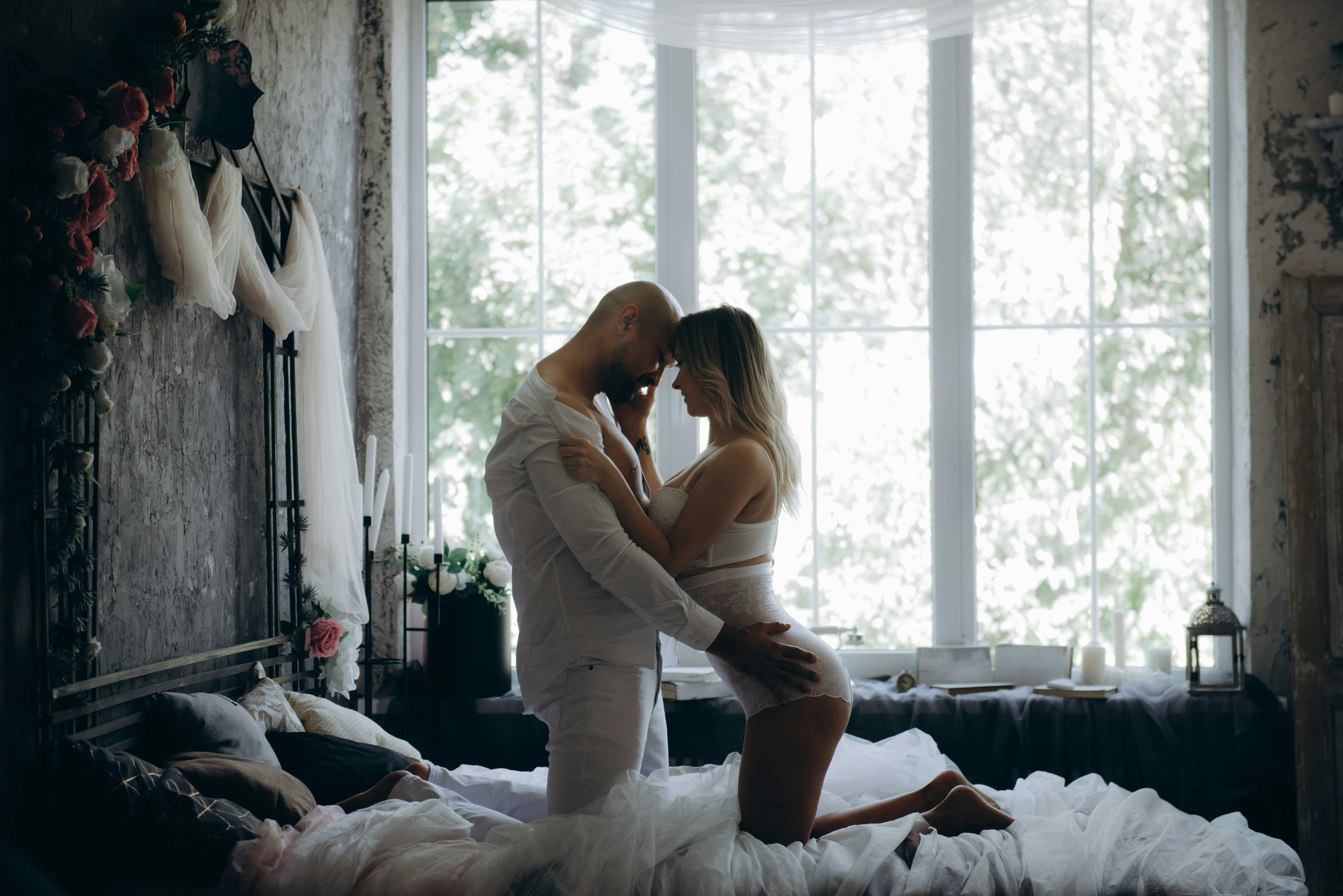Why Wear A Bonnet To Bed

Wearing a bonnet to bed may seem like an old-fashioned practice, however there are several reasons why it can be beneficial. Bonnets provide a number of benefits when worn to bed, such as keeping your hair moisturized, maintaining your hairstyle, protecting your hair from breakage, and helping you sleep more comfortably. In addition to these practical benefits, wearing a bonnet to bed can also be quite stylish and fashionable. Therefore, wearing a bonnet to bed is a great way to keep your hair healthy and achieve the perfect look for any occasion.Wearing a bonnet to bed can have many benefits. Bonnets are lightweight and comfortable, making them ideal for sleeping in. They help to keep your hair tucked away, preventing it from getting tangled and matted during sleep. Bonnets also help to protect your hair from damage caused by friction against your pillowcase. Furthermore, bonnets can help to keep your head warm during colder months, helping to prevent headaches and other uncomfortable side effects of cold temperatures. Additionally, bonnets can provide protection from dust and allergens while you sleep. Lastly, wearing a bonnet can be a great way to express your personal style in the bedroom.
Types of Bonnets to Wear to Bed
Wearing a bonnet to bed is an important part of protecting your hair and keeping it looking good. There are many different types of bonnets available, and it can be difficult to decide which one is right for you. Here are some of the most popular types of bonnets to wear to bed:
Silk Bonnets – Silk bonnets are great for those who want a soft, luxurious material against their skin. Silk is also incredibly gentle on the hair, so it helps to keep your hairstyle looking its best. They come in a variety of colors and styles, so you’re sure to find one that suits your style and needs.
Satin Bonnets – Satin bonnets are popular because they provide excellent coverage and protection for your hair while you sleep. They’re usually made from a combination of satin and cotton or polyester, which helps to keep the material lightweight yet strong enough to withstand regular use. Satin bonnets come in a variety of colors and patterns, so you can choose one that fits your style and personality perfectly.
Cotton Bonnets – Cotton bonnets are lightweight yet durable, making them an ideal choice for those who want something that won’t break the bank but still provides a good amount of protection for their hair. Cotton also helps keep the scalp cool while you sleep, which can help reduce frizziness in the morning. Cotton bonnets come in a wide range of colors and patterns, so you’re sure to find one that suits your needs perfectly.
Organic Bonnets – Organic bonnets are made from natural materials such as hemp or bamboo fibers that have been grown without any chemicals or pesticides. These materials are gentle on both your scalp and hair, providing excellent coverage without causing any irritation or buildup on the scalp. Organic bonnets also come in a variety of colors and prints, so you’re sure to find one that fits your style perfectly.
No matter what type of bonnet you decide on, wearing one at night will help keep your hair looking its best and protect it from damage caused by friction against pillows or sheets while you sleep.
What Materials are Used in Bonnets?
Bonnets are traditionally made from a variety of materials, depending on the style of the bonnet. Common fabrics used for bonnets include cotton, silk, wool, and linen. Felt and straw are also popular materials for making bonnets. For more decorative bonnets, lace or ribbon may be used as trim or edging. For more formal occasions, velvet and satin are often used to create a luxurious look. Bonnet frames may be made from wire or straw and covered with fabric or ribbon to create structure and shape.
Where Can You Buy a Bonnet?
Bonnets are a classic, timeless accessory that can add a touch of elegance and sophistication to any outfit. Whether you’re looking for a traditional style or something more modern, there are plenty of places to buy bonnets that will meet your needs.
Online retailers such as Amazon and eBay offer an extensive selection of bonnets in a variety of styles, fabrics, colors, and sizes. You can even find vintage bonnets if you’re looking for something truly unique. Shopping online also gives you the opportunity to compare prices between different sellers so that you can get the best deal.
Local antique shops and thrift stores are also great places to look for bonnets. You may be able to find some rare or one-of-a-kind items at these stores, and they usually have very reasonable prices. Be sure to check the condition of the bonnet before making your purchase; some older items may need special care or restoration before they can be worn again.
If you’re looking for something handmade or custom made, consider visiting your local craft fairs or boutiques. Many artisans specialize in making custom bonnets with unique fabrics and designs, so you may be able to find something truly special here. Prices will vary depending on the materials used and the time spent crafting the item, but it’s worth it if you’re looking for something truly unique.
Finally, don’t forget about department stores such as Macy’s or Nordstrom’s. They usually carry an extensive selection of bonnets in various styles and sizes, as well as accessories such as veils and ribbons that can help complete the look. Department stores often offer discounts on certain items during seasonal sales or holidays, so be sure to keep an eye out for those offers!
How to Ensure Your Bonnet Fits Properly
Finding the right fit for your bonnet is essential for keeping your hair healthy and protected. When your bonnet is too tight, it can cause breakage or damage to your hair, while a bonnet that is too loose can let in moisture and cause frizz. Here are some tips for ensuring that you get the right fit for your bonnet:
1. Measure Your Head: Before you purchase a bonnet, measure the circumference of your head with a soft measuring tape. This will ensure that you have the correct size when you make a purchase.
2. Choose an Adjustable Bonnet: Look for a bonnet with an adjustable strap or drawstring so that you can make sure it fits snugly on your head without being too tight.
3. Try It On: Whenever possible, try on the bonnet before purchasing it to make sure it fits comfortably and securely on your head.
4. Look for Quality Materials: Avoid synthetic materials such as polyester or nylon which can irritate the scalp and cause sweating. Instead, opt for natural materials such as silk, cotton, or satin which are more gentle on the hair and scalp while still providing protection from moisture and friction.
5. Check The Seams: Make sure there are no gaps between the seams of the bonnet so that it fits snugly on your head without any gaps where air or moisture can get in.
Following these simple steps will ensure that you find a bonnet that fits properly and keeps your hair healthy and protected from damage due to friction or moisture buildup.

Tips for Wearing a Bonnet to Bed
Bonnets are the perfect way to keep your hairstyle in place while you sleep. Bonnets are also a great way to protect your hair from becoming dry and brittle due to friction from sleeping on it. Here are some tips for wearing a bonnet to bed:
Make sure the bonnet is the correct size for your head. Too small and it won’t stay in place, too big and it will be uncomfortable and won’t provide enough coverage for your hair. Make sure the bonnet is made of breathable material, like silk or cotton, so that your scalp can breathe while you sleep.
Secure the bonnet with an elastic band or ties so that it won’t move around while you sleep. This will also help keep any stray hairs tucked away as well.
Wash your bonnet regularly, especially if you use styling products or oils in your hair. This will help keep it fresh and free of build-up.
If you have long hair, tie it up into a bun or braid before putting on your bonnet. This will help keep the style in place and reduce tangles.
Finally, make sure to take off the bonnet in the morning before styling your hair. Doing this will help prevent breakage from pulling and tugging at knots caused by sleeping with a bonnet on.
Avoid Wearing Your Bonnet Too Tightly
When wearing a bonnet to bed, it is important to avoid wearing it too tightly. Doing so can cause discomfort and lead to headaches. It is also important to make sure the bonnet fits properly and does not squeeze the head or cause any pressure points. The bonnet should feel comfortable and secure without being too tight.
Do Not Sleep With Wet Hair
It is not recommended to sleep with wet hair when wearing a bonnet to bed. Doing so can cause damage to the hair as well as increase the risk of fungal or bacterial infections. Allow your hair to dry completely before putting on a bonnet for bedtime.
Do Not Wear Bonnets for Long Periods of Time
Bonnets should not be worn for extended periods of time, as this can cause breakage and split ends in the hair. Bonnets are best used for short-term protection or styling, such as when sleeping or styling updos or braids. Be sure to take off your bonnet regularly and give your hair a break from being confined under fabric.
Avoid Synthetic Materials
When selecting a bonnet for sleeping, avoid synthetic materials such as nylon or polyester, which can lead to sweating and irritate the scalp. Opt for breathable fabrics like cotton or silk instead, which will help keep the head cool and comfortable while sleeping with a bonnet on.
Common Misconceptions About Wearing a Bonnet to Bed
Wearing a bonnet to bed is often seen as an outdated practice, but it’s actually still quite popular amongst those looking for an alternative way to protect their hair. However, there are some common misconceptions about wearing a bonnet to bed that can be easily debunked.
One of the most common misconceptions is that wearing a bonnet will make your hair look flat and lifeless. In reality, this isn’t the case at all. A bonnet can actually help maintain the natural shape of your hairstyle, by keeping any products you’ve used on your hair from rubbing off throughout the night.
Another misconception is that wearing a bonnet will cause you to sweat more during the night. This isn’t true either; in fact, wearing a bonnet can help regulate your body temperature by keeping your head warm and preventing heat loss.
Finally, there’s also the misconception that wearing a bonnet will make you look unattractive when you wake up in the morning. While it’s true that wearing a bonnet may have this effect if you don’t take proper care of it, if you choose the right type of material and keep it clean, it won’t have any noticeable effect on how you look when you wake up in the morning.
By understanding these common misconceptions about wearing a bonnet to bed, you can feel more confident about incorporating this practice into your nighttime routine and protecting your hair while you sleep.

Conclusion
Wearing a bonnet to bed is a simple way to make sure your hair stays looking its best. Not only does a bonnet protect your hair from damage, but it also keeps your hair moisturized and helps to maintain its natural shine. Bonnets are comfortable, affordable, and easy to use. Plus, they come in a variety of colors and styles so you can choose the one that best suits your needs. Wearing a bonnet is an effective way to keep your hair looking healthy and beautiful.
In conclusion, wearing a bonnet to bed is an easy and affordable way to keep your hair looking its best. Bonnets provide protection from damage, help retain moisture, and can help you maintain healthy-looking tresses. With so many styles and colors available, you’re sure to find the perfect bonnet for you. So don’t wait any longer—try wearing a bonnet tonight and see the difference for yourself!
